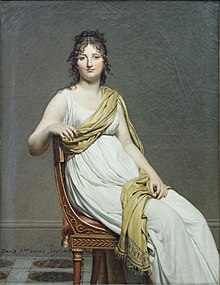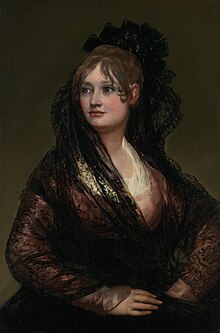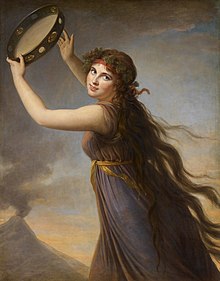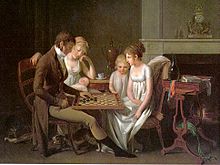For women's dress, the day to day outfit of the skirt and jacket style were practical and tactful, recalling the working class woman. Women's fashions followed classical ideals, and tightly laced corsets were temporarily abandoned in favor of a high-waisted, natural figure. This natural figure was emphasized by being able to see the body beneath the clothing. Visible breasts were part of this classical look, and some characterized the breasts in fashion as solely aesthetic and sexual.
In Britain, Beau Brummell introduced trousers, perfect tailoring, and unadorned, immaculate linen as the ideals of men's fashion. In Germany, republican city-states relinquished their traditional, modest, and practical garments and started to embrace the French and English fashion trends of short-sleeved chemise dresses and Spencer jackets. American fashion trends emulated French dress, but in a toned down manner with shawls and tunics to cope with the sheerness of the chemise. However, in Spain, members of the Aristocracy, as well as citizens of the lower class, united and rebelled against French enlightenment ideals and fashion by dressing as majas and majos to contain their Spanish pride.
By the end of the eighteenth century, a major shift in fashion was taking place that extended beyond changes in mere style to changes in philosophical and social ideals. Prior to this time, the style and traditions of the “Ancien Régime” prevented the conceptualization of “the self”. Instead, one’s identity was considered malleable; subject to change depending on what clothes one was wearing. However, by the 1780s, the new, “natural” style allowed one’s inner self to transcend their clothes.
During the 1790s, there was a new concept of the internal and external self. Before this time, there had only been one self, which was expressed through clothing. When going to a masquerade ball, people wore specific clothing, so they could not show their individuality through their clothing. Since, for everyday dress, most people wore similar clothing, people used accessories to show their individuality. These accessories and the detail on the clothing were more important than the shape of the dress.
Incorporated in this new “natural” style was the importance of ease and comfort of one's dress. Not only was there a new emphasis on hygiene, but also clothing became much lighter and more able to be changed and washed frequently. Even upper class women began wearing cropped dresses as opposed to dresses with long trains or hoops that restricted them from leaving their homes. In a sense, women were influenced by male fashion, such as tailored waistcoats and jackets to emphasize women’s mobility. This new movement toward practicality of dress showed that dress became less of a way to solely categorize between classes or genders; dress was meant to suit one's personal daily routine. It was also during this time period that the fashion magazine and journal industry began to take off. They were most often monthly (often competing) periodicals that allowed men and women to keep up with the ever-changing styles.
Influence of Industrial Revolution on fashion
In the late 18th century, clothes were mostly sold by individual shopkeepers who were often the artisans who made the goods. Customers usually lived in the same neighborhood as the shops and the shops would gain popularity by their customers’ word-of–mouth recommendation, with the exception of warehouses (i.e., any retail on wholesale), where goods being sold were not necessarily made in the shop. However, things started to change during the transition to the 19th century. People sought efficiency and variety; under the influence of the Industrial Revolution, improved transportation and introduction of machines in manufacturing allowed fashion to develop at an even faster pace.
The first sewing machine emerged in 1790, and later, Josef Madersperger began developing his first sewing machine in 1807, presenting his first working machine in 1814. The introduction of the sewing machine sped up garment production. Meanwhile, advanced spinning, weaving and cotton-printing techniques developed in the 18th century had already brought detailed, washable fabrics. These durable and affordable fabrics became popular among the majority population. These techniques were further developed by the introduction of machines. Before, accessories like embroidery and lace were manufactured on a small and limited scale by skilled craftsmen and sold in their own shops; in 1804, a machine for embroidering was constructed by John Duncan, and people started producing these essential accessories in factories and dispatching the products to shops throughout the country. These technical developments in clothing production allowed a greater variety of styles; rapid changes in fashion also became possible.
The Industrial Revolution bridged Europe and America with regards to travel. When Louis Simond first arrived to America, he was struck by the mobility of the population and frequency of people made trips to the capital, writing "you meet nowhere with those persons who never were out of their native place, and whose habits are wholly local — nobody above poverty who has not visited London once in his life; and most of those who can, visit once a year.’ New canals and railways not only transported people, but created national and even broader markets by transporting goods that manufactured in factories in great distances. The rise of industry throughout the Western world increased garment production and people were encouraged to travel more widely and purchase more goods than ever before.
Communication was also improved in this era. New ideas about fashion were conveyed by little dolls dressed in the latest style, newspapers, and illustrated magazines; for example, La Belle Assemblée, founded by John Bell, was a British women's magazine published from 1806 to 1837. It was best known for its fashion plates of Regency era styles, showing how women should dress and behave. When fashion became available for everybody, people were expected to dress according to the latest fashion. Dressmakers would show the fashion-plates to their customers, so that customers could catch up to the latest styles.
Changes in fashion
1790s:
Women: "age of undress"; dressing like statues coming to life; fillet-Greek classical hairstyle; simple muslin chemise w. ribbon; sheer; empire silhouette; pastel fabrics; natural makeup; bare arms; blonde wigs; accessorized with (to demonstrate individuality): hats, turbans, gloves, jewelry, small handbags - reticules, shawls, handkerchiefs; parasols; fans; Maja: layered skirt
Men: trousers w. perfect tailoring; linen; coats cutaway in the front w. long tails; cloaks; hats; the Dandy; Majo: short jacket
1800s:
Women: short hair; white hats; trim, feathers, lace; Egyptian and Eastern influences in jewelry and apparel; shawls; hooded-overcoats; hair: masses of curls, sometimes pulled back into a bun
Men: linen shirts w. high collars; tall hats; hair: short and wigless, à la Titus or Bedford Crop, but often with some long locks left coming down
1810s:
Women: soft, subtle, sheer classical drapes; raised back waist of high-waisted dresses; short-fitted single breasted jackets; morning dress; walking dress; evening dress; riding habits; bare bosoms and arms; hair: parted in the center, tight ringlets over the ears
Men: fitted, single-breasted tailcoats; cravats wrapped up to the chin; sideburns and "Brutus style" natural hair; tight breeches; silk stockings; accessorized with: gold watches, cane, hats outside.
1820s:
Women: dress waist lines began to drop; elaborate hem and neckline decoration; cone-shaped skirts; sleeves pinched
Men: overcoats/greatcoats w. fur or velvet collars; the Garrick coat; Wellington boots; jockey boots
Women's fashion
Overview
In this period, fashionable women's clothing styles were based on the Empire silhouette — dresses were closely fitted to the torso just under the bust, falling loosely below. In different contexts, such styles are commonly called "Directoire style" (referring to the Directory government of France during the second half of the 1790s), "Empire style" (referring to Napoleon's 1804–1814/1815 empire, and often also to his 1800–1804 "consulate"), or "Regency" (most precisely referring to the 1811–1820 period of George IV's formal regency, but often loosely used to refer to various periods between the 18th century and the Victorian).
These 1795–1820 fashions were quite different from the styles prevalent during most of the 18th century and the rest of the 19th century, when women's clothes were generally tight against the torso from the natural waist upwards, and heavily full-skirted below (often inflated by means of hoop skirts, crinolines, panniers, bustles, etc.). The high waistline of 1795–1820 styles took attention away from the natural waist, so that there was then no point to the tight "wasp-waist" corseting often considered fashionable during other periods. Without the corset, chemise dresses displayed the long line of the body, as well as the curves of the female torso.
Gowns
Inspired by neoclassical tastes, the short-waisted dresses sported soft, loose skirts and were often made of white, almost transparent muslin, which was easily washed and draped loosely like the garments on Greek and Roman statues. Since the fabric clung to the body, revealing what was underneath, it made nudity à la grecque a centerpiece of public spectacle. Thus during the 1795–1820 period, it was often possible for middle- and upper-class women to wear clothes that were not very confining or cumbersome, and still be considered decently and fashionably dressed.
Silhouette
Due to the importance of showing social status, the fashion industry was very much influenced by society during the Regency era. One's position was determined by the person’s wealth, etiquette, family status, intelligence, and beauty. Women financially and socially relied on their husbands. The only socially-acceptable activities in which women could participate centered around social gatherings and fashion, the most important component of which was attending evening parties. These parties helped to build relationships and connection with others. As etiquette dictated different standards of attire for different events, afternoon dress, evening dress, evening full dress, ball dress, and different type of dresses were popular.
Hairstyles and headgear
During this period, the classical influence extended to hairstyles. Often masses of curls were worn over the forehead and ears, with the longer back hair drawn up into loose buns or Psyche knots influenced by Greek and Roman styles. By the later 1810s, front hair was parted in the center and worn in tight ringlets over the ears. Adventurous women like Lady Caroline Lamb wore short cropped hairstyles "à la Titus", the Journal de Paris reporting in 1802 that "more than half of elegant women were wearing their hair or wig à la Titus", a layered cut usually with some tresses hanging down.
Undergarments
Fashionable women of the Regency era wore several layers of undergarments. The first was the chemise, or shift, a thin garment with tight, short sleeves (and a low neckline if worn under evening wear), made of white cotton and finished with a plain hem that was shorter than the dress. These shifts were meant to protect the outer-clothes from perspiration and were washed more frequently than outer clothes. In fact, washer women of the time used coarse soap when scrubbing these garments, then plunged them in boiling water, hence the absence of color, lace, or other embellishments, which would have faded or damaged the fabric under such rough treatment. Chemises and shifts also prevented the transparent muslin or silk dresses from being too revealing.
Outerwear and shoes
During this time period, women's clothing was much thinner than in the eighteenth century so warmer outerwear became important in fashion, especially in colder climates. Coat-like garments such as pelisses and redingotes were popular, as were shawls, mantles, mantelets, capes and cloaks. The mantelet was a short cape that was eventually lengthened and made into a shawl. The redingote, another popular example, was a full-length garment resembling a man's riding coat (hence the name) in style, that could be made of different fabrics and patterns. Throughout the period, the Indian shawl was the favoured wrap, as houses and the typical English country house were generally draughty, and the sheer muslin and light silk dresses popular during this time provided less protection. Shawls were made of soft cashmere or silk or even muslin for summer. Paisley patterns were extremely popular at the time.
Accessories
Gloves were always worn outside the house. When worn inside, as when making a social call, or on formal occasions, such as a ball, they were removed when dining. About the length of the glove, A Lady of Distinction writes:
Style gallery

1-1798-99
| 
2-1805
| 
3-1790
| 
4-1808
| 
5-1807
|
|---|
1.Madame Raymond de Verninacby Jacques-Louis David, with clothes and chair in Directoire style. "Year 7", that is 1798-99.
2.In Spain, some society ladies rebelled against French fashion by dressing as majas, like Doña Isabel de Porcel, 1805.
3.Portrait of Emma, Lady Hamiltonby Elisabeth Vigée-Lebrun ca. 1790s.
4.French lady in 1808; the style was often accompanied by a shawl or similar wrap, or a short "Spencer" jacket, as the dresses were light and left much uncovered
5.Portrait of Caroline Murat and her daughter Letizia, painted in 1807 by Elisabeth Vigée-Lebrun. Madame Murat wears the formal red train of court dress over her high-waisted gown.
Men's fashion
Overview
This period saw the final abandonment of lace, embroidery, and other embellishment from serious men's clothing outside of formalized court dress—it would not reappear except as an affectation of Aesthetic dress in the 1880s and its successor, the "Young Edwardian" look of the 1960s. Instead, cut and tailoring became much more important as an indicator of quality. This transformation can be attributed in part to an increased interest in antiquity stemming from the discovery of classical engravings, including the Elgin Marbles. The figures depicted in classical art were viewed as an exemplar of the ideal natural form, and an embodiment of Neoclassical ideas. Therefore, in the 18th century, dress was simplified and greater emphasis was put on tailoring to enhance the natural form of the body.
The rise of the dandy
The clothes-obsessed dandy first appeared in the 1790s, both in London and Paris. In the slang of the time, a dandy was differentiated from a fop in that the dandy's dress was more refined and sober. The dandy prided himself in "natural excellence" and tailoring allowed for exaggeration of the natural figure beneath fashionable outerwear.
Hairstyles and headgear
During this period, younger men of fashion began to wear their hair in short curls, often with long sideburns. In 1795, Pitt's hair powder tax effectively ended the fashion for wigs and powder, and new styles like the Brutus and the Bedford Crop became fashionable. Older men, military officers, and those in conservative professions such as lawyers, judges, physicians, and servants retained their wigs and powder. Formal court dress also still required powdered hair.
Tricorne and bicorne hats were still worn, but the most fashionable hat was tall and slightly conical; this would evolve into the top hat and reign as the only hat for formal occasions for the next century.
Style gallery

1-1795
| 
2-1797
| 
3-1795.
| 
4-1815
|  5-1803 5-1803 |
|---|
1.Pierre Seriziat in riding dress, 1795. His snug leather breeches have a tie and buttons at the knee and a fall front. The white waiscoat is double-breasted, a popular style at this time. His tall hat is slightly conical.
2.A Directoire dandy in 1797, by Girodet; Portrait of Jean-Baptiste Belley, Deputy for Saint-Domingue.
3.Artist Jean-Baptiste Isabey wears a cropped riding coat and dark breeches tucked into boots. He carries his hat and gloves, 1795.
4.This gentleman wears a double-breasted frockcoat in dark blue over a buff waistcoat. His gray trousers have straps under his shoes. His slightly conical tall hat sits in the windowsill, Germany, c. 1815 (by Georg Friedrich Kersting).
5.Painting of a family game of checkers ("jeu de dames") by French artist Louis-Léopold Boilly, c. 1803.
Children's fashion
Both boys and girls wore dresses until they were about four or five years old, when boys were "breeched", or put into trousers.

Mozart's sons, 1798
| 
United States, 1798
| 
Young girl, Paris, 1803
| 
Skeleton suit, 1806
| 
England, 1815
|
|---|
Revival of Directoire/Empire/Regency fashions
During the first half of the Victorian era, there was a more or less negative view of women's styles of the 1795–1820 period. Some people would have felt slightly uncomfortable to be reminded that their mothers or grandmothers had once promenaded about in such styles (which could be considered indecent according to Victorian norms), and many would have found it somewhat difficult to really empathize with (or take seriously) the struggles of a heroine of art or literature if they were being constantly reminded that she was wearing such clothes. For such reasons, some Victorian history paintings of the Napoleonic wars intentionally avoided depicting accurate women's styles, Thackeray's illustrations to his book Vanity Fair depicted the women of the 1810s wearing 1840s fashions, and in Charlotte Brontë's 1849 novel Shirley (set in 1811–1812) neo-Grecian fashions are anachronistically relocated to an earlier generation.
Later in the Victorian period, the Regency seemed to retreat to an unthreateningly remote historical distance, and Kate Greenaway and the Artistic Dress movement selectively revived elements of early 19th century fashions. During the late Victorian and Edwardian periods, many genre paintings, sentimental valentines, etc. contained loose depictions of 1795–1820 styles (then considered to be quaint relics of a bygone era). In the late 1960s / early 1970s, there was a limited fashion revival of the Empire silhouette.
In recent years, 1795–1820 fashions are most strongly associated with Jane Austen's writings, due to the various movie adaptations of her novels. There are also some Regency fashion "urban myths", such as that women dampened their gowns to make them appear even more diaphanous (something which was certainly not practiced by the vast majority of women of the period).

1 – 1857 cartoon
| 
2 – 1868 denial
| 
3 – 1882 nostalgia
| 
4 – Kate Greenaway
|
|---|
1.An 1857 cartoon making fun of the contemporary distaste for early 19th century clothes.
2."Before Waterloo" by Henry Nelson O'Neil (1868), a mid-Victorian painting which deliberately does not show accurate women's styles of 1815.
3."Two Strings to her Bow" by John Pettie (1882), a later Victorian genre painting which uses the Regency period for nostalgia value.
4.May Day by Kate Greenaway.
Source from Wikipedia
没有评论:
发表评论